Not only is Kaş an adorable seaside town, its setting on a historic marine trading route means that its coastline is rich in history. We absolutely loved exploring the gorgeous coast and historic sites around this charming town. Here are the best sites near Kaş, Turkey.
Kaş
Originally settled as a fishing village, Kaş is now a fully fledged tourist destination. Even with its numerous beach-style restaurants and boutique hotels, it is extremely quaint and you will undoubtedly fall in love with Kaş.
Part of its charm is its hilly Old Town. Cobblestone streets climb up and down the hills, taking you between Ottoman heritage buildings that are now quaint cafes or artists shops.
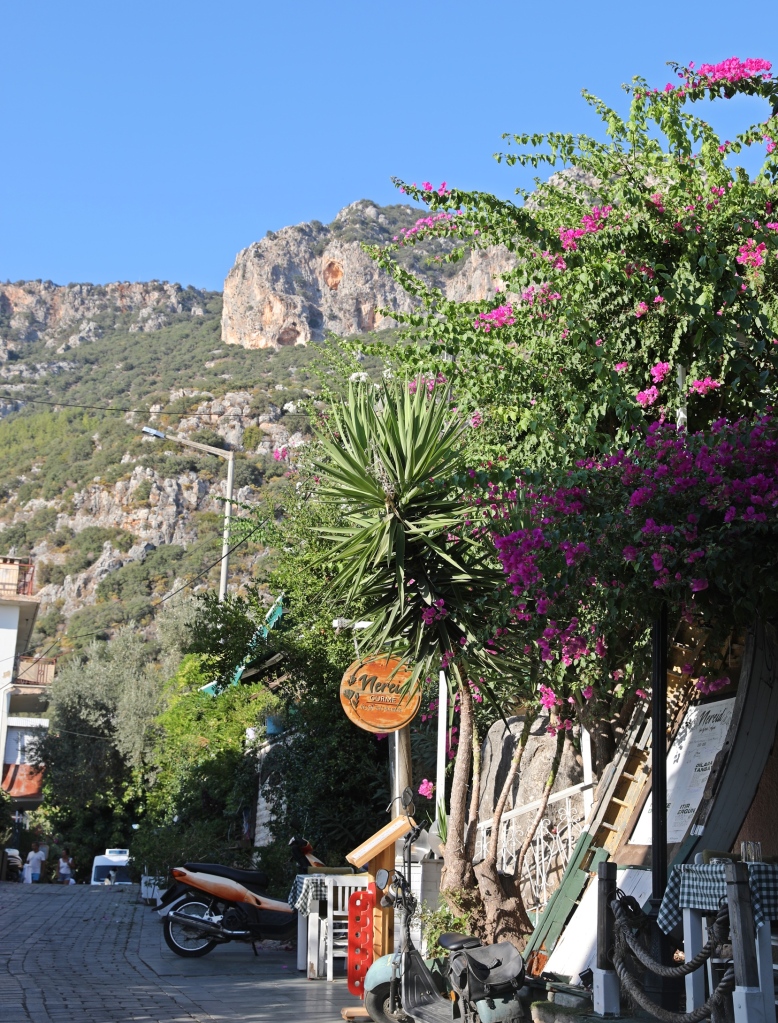

The other component to the town’s charm is its location on the Turquoise Coast. From one of the hills above town, we enjoyed sweeping views of the coast. A few green islands added texture to the brilliant turquoise water. Kaş is picture-perfect.


The town’s port hosts a mix of small fishing boats, dive boats and pleasure crafts. The rugged cliffs behind the small port makes another postcard-worthy scene.
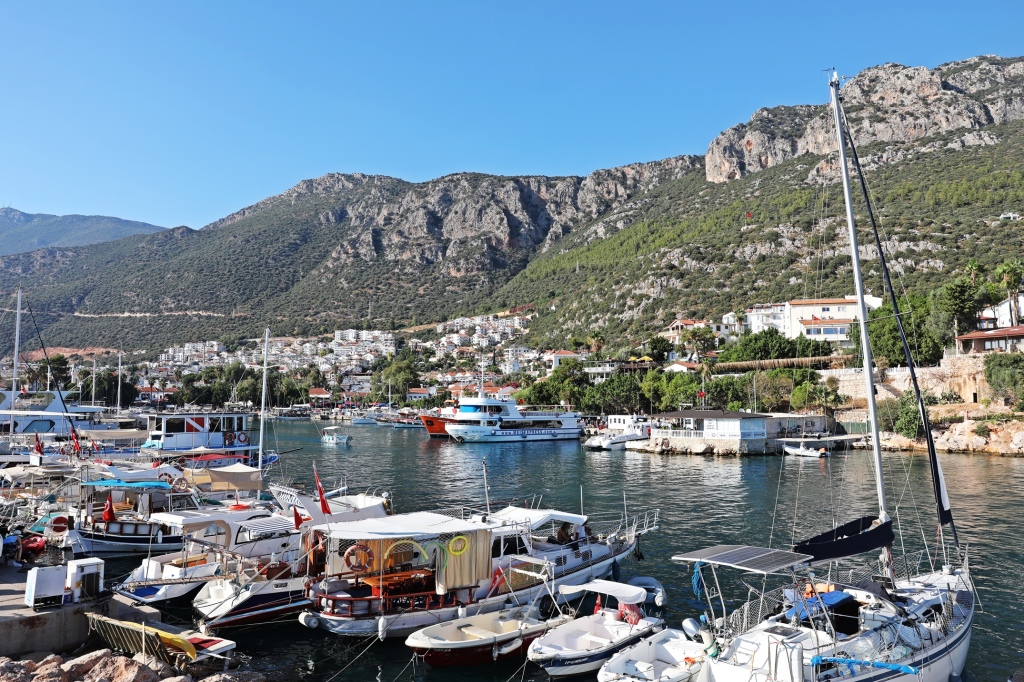

Most of the historical remains are gone from town, but you can still find a couple of 4th century BCE Lycian tombs as well as a restored Roman theatre. The tombs look like little stone boxes and stand out as the more modern town was built around them.
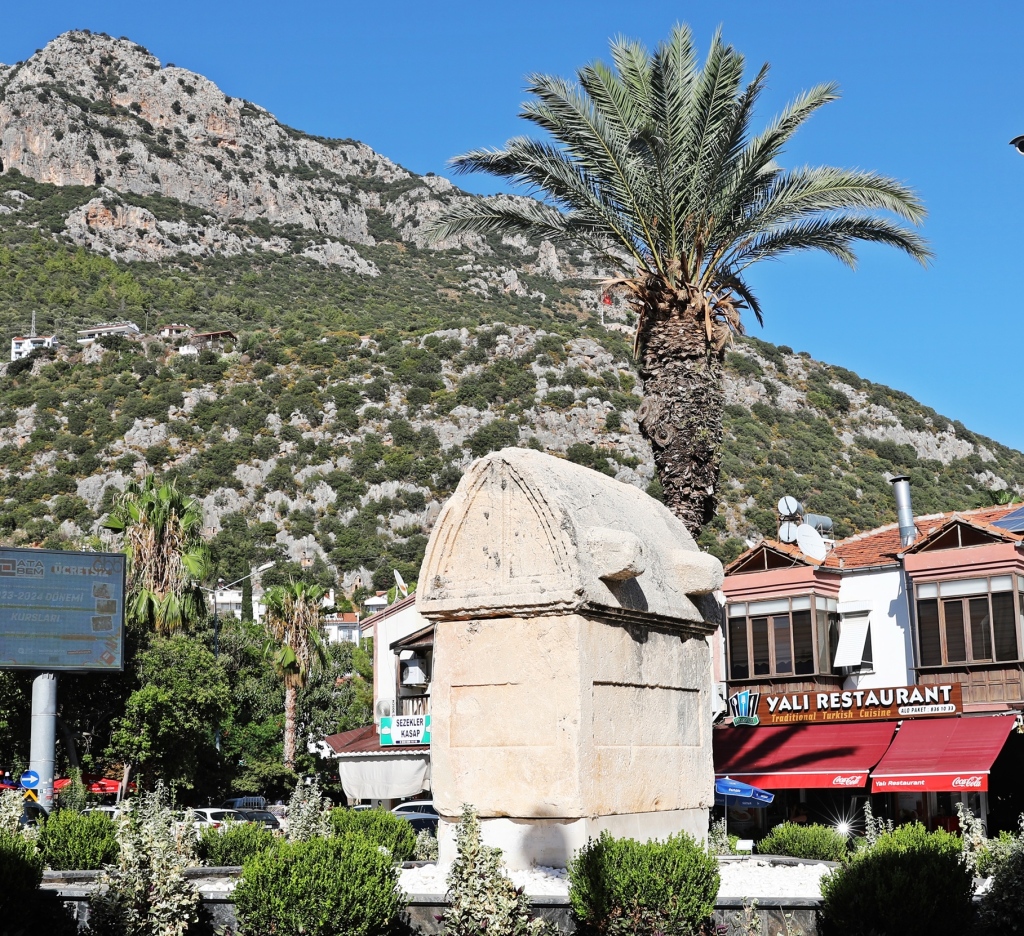

The town is so cute that you may be tempted to spend all of your time there. Doing that however, would mean that you’d miss out on all of the amazing sites located nearby.
In addition to the lovely town, there are a few great things to see on day trips from Kaş. Many can be done from other nearby cities and towns such as Antalya and Fethiye, but we’re glad we based ourselves out of Kaş.
Kekova
The Lycians ruled this part of the Mediterranean from the 15th to 1th centuries BCE. It was called Lycia and extended 500 km from Antalya to Fethiye. In ancient times marine trade was growing in the Mediterranean and the Lycians built commercial spaces for trading all along this coast. As a result, the shores around Kaş are teeming with historical artifacts. Kekova is the name for the region as well as most famous island. One of the best ways to see these sites is on a boat cruise.
We hesitated before booking a cruise because we don’t like to take tours, and especially boat tours since they often turn into party boats. We are so happy that we decided to take this tour because the sites were interesting, and there wasn’t a party; not on our boat anyway.
As soon as our boat pulled out of the rocky bay of Üçağız we were already immersed in stunning scenery. The pretty bay is dotted with small rocky islands.


Out boat stopped at a few picturesque places to swim in the blue waters of Turkey’s Mediterranean. At a few of these spots we were anchored beside an island with ancient ruins. Swimming beside an ancient city was the most unique ways to view ruins we’ve ever had. This cruise was already better than we expected.


The most famous island in this area is Kekova. It is home to the sunken city ancient city of Dolichiste. When we reached the edge of the island, our boat slowed down so we had lots of time to see the famous sunken city. At first we passed by the ruins of the seawall. As we travelled further we could see remnants of walls, floors and doorways. The most interesting was seeing staircases that led into the Mediterranean. Some of the city is 1,518 m below sea-level and these stairs looked to be leading down to it.


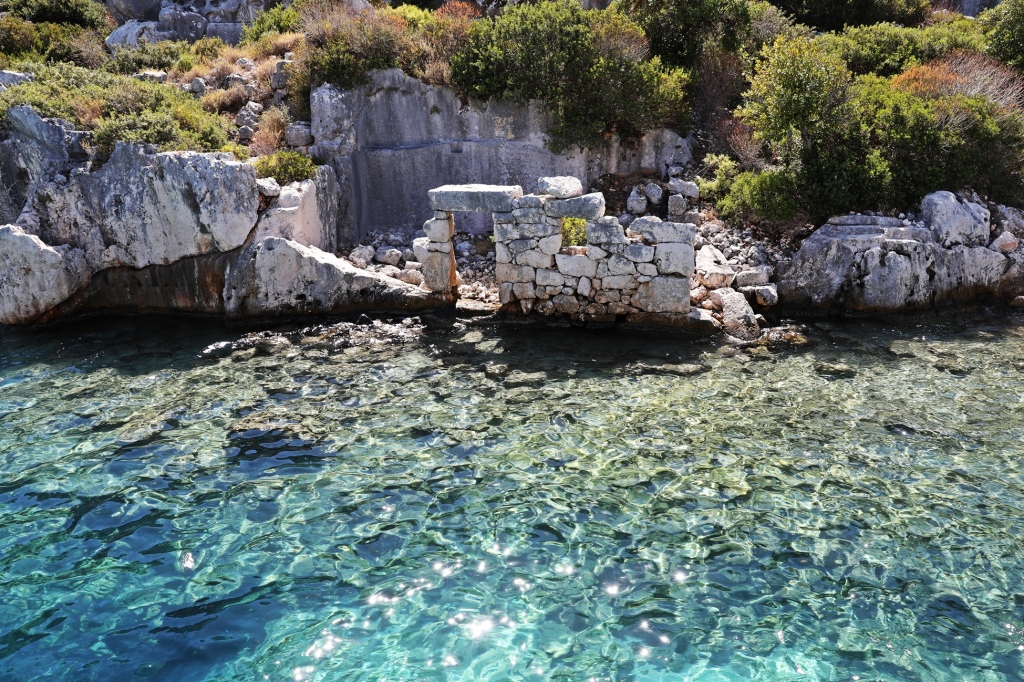
Archaeologists don’t know the exact dates when the merchant city was built, but they believe it was before the 1st century BCE. At its largest the city had up to 250 homes for 2000 residents. In the 2nd century AD, an earthquake resulted in much of the city being covered by the sea. After the earthquake the Byzantines did rebuild in the area, but battles with Arabs forced them to abandon it in the 7th century.
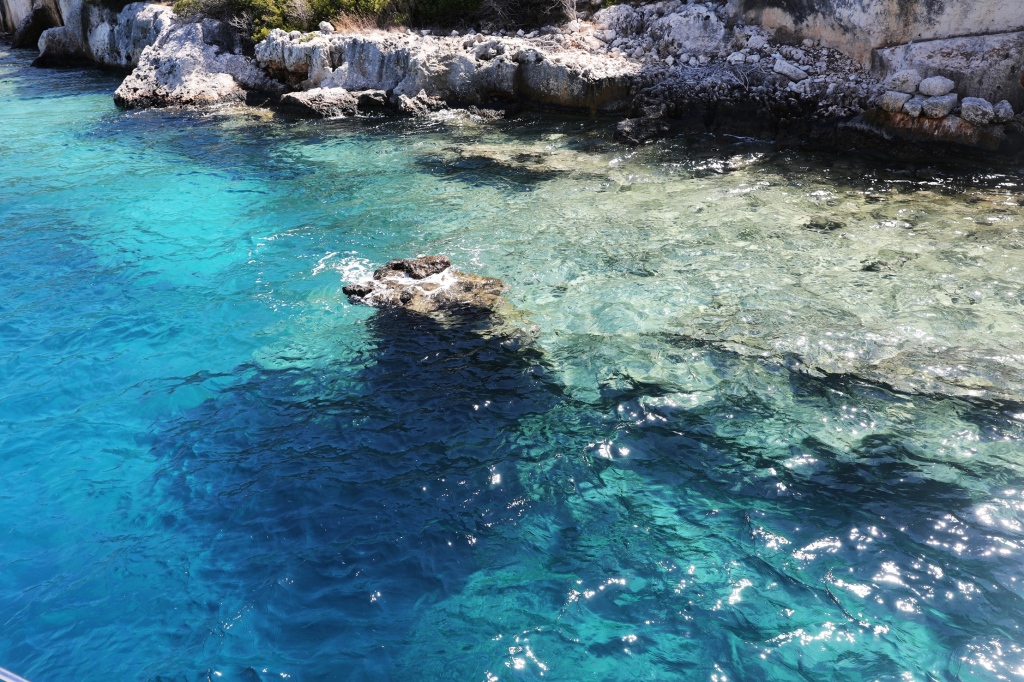
Today the island of Kekova is uninhabited and since the 1990s no one has been allowed to walk on the island or even swim over the ruins. Even from the boat we could see some of the vandalism that was done before this law came into effect.
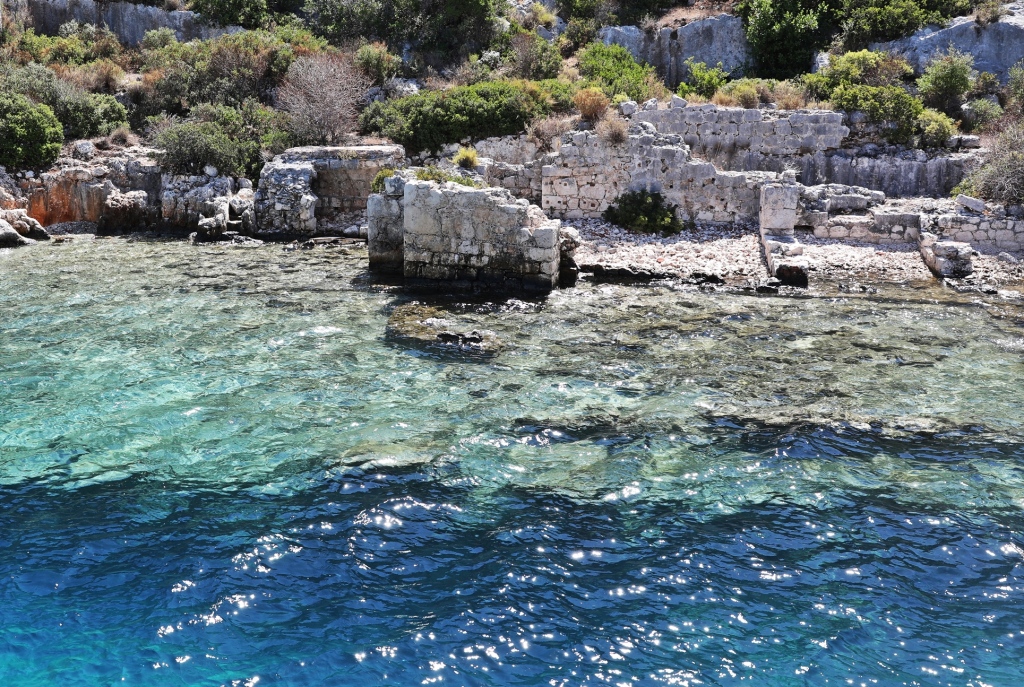
After the sunken city we cruised around this beautiful coast passing more picturesque islands.


Another great stop was the boat-access only village of Kaleköy. Established in the 4th century BCE, this Lycian city was once called Simena. Before reaching the village we could see tombs of a Lycian necropolis on top of the hill.
Along the shore are the colourful 19th century homes lived in by Greeks until 1923. Today some of the homes are lived in by Turks, but a lot are used as restaurants and small shops. Sitting in the water in front of the homes is another Lycian tomb. Its location in the water is another reminder of the 1st century earthquake.



On the top of the hill are the remains of a castle built by Rhodes knights. There’s not much to see inside Simena Castle, but the coastal views you get from its ramparts are unmatched.



Patara
Forty kilometers from Kaş are the ruins of an important Lycian city. The present-day town of Patara sits near the ancient Lycian city of Termilae. In the 13th century BCE, the town was a part of the prosperous ancient maritime trade route. For a relatively unknown civilization, the Lycians had some incredible accomplishments. Not only did they give us attractive architecture, but they are also considered the world’s first democratic federation. The Lycian League was a group of elected representatives from 23 Lycian states who would meet to discuss the running of their collective society. Termilae was the major meeting point of the Lycian League of representatives and you can visit their restored Assembly Hall. This federation was so revolutionary, it was even used as a reference when writing the US constitution.

The largest building remaining in Termilae is the theatre. Its similar to most of the Greco-Roman theatres we’ve seen except that some of the seats even have carved backs.

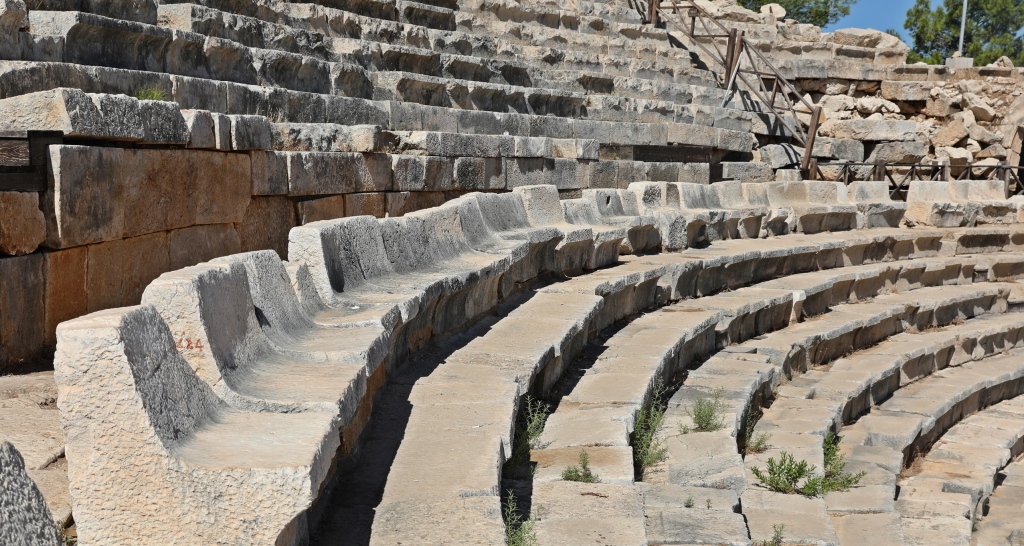
There area a few more ruins scattered about the large area including columns that line Harbour Street, the pretty Triple Vaulted City Gate and a replica of an ancient Egyptian boat. It is said to be the type of boat that would have used the harbour.
As we wandered through the ruins we learned that one of the most famous people in Christian folklore was born in Termilae. In 270 AD, the inspiration for today’s Santa Claus, St. Nicholas, was born here. Wait a minute, what? Santa Claus is from Turkey? He was and we learned more about him when we visited Myra next.




Patara Beach
A kilometer from the ancient site is Patara Beach. It’s a long beach with a few sand dunes on the side where turtles hatch. It is touted as being one of the nicest beaches in Turkey. It is the first beach in this region that we saw with sand but it’s very grainy and the colour is a drab brown. Maybe we’re a little spoiled from Brazil, but the beach was not enough to entice us to stay.

Entrance Fee – 340 TRY ($11 USD); Opening Hours – 8am-8pm The entrance fee for the archeological site includes entrance to the beach.
Getting to Patara
Minibuses (dolmaş) run every 30 minutes from Kaş to Patara. (60 TRY/$2 USD). You have to change minibuses after about 35 minutes. The fee for the second minibus is included in the fee for the first one, but we didn’t know and got scammed 20 TRY. That’s only 60 cents, so we weren’t too upset.
Myra
Only a few kilometers north of Kaş are the ruins of the ancient city Myra. Built on the fertile alluvial plain, the 5th century BCE town was an important center for Lycians. Today all that’s left are the remains of the necropolis and theatre.
The necropolis is fascinating and makes the trip to Myra more than worth it. We stood in awe as we looked up at dozens of 5th century BCE rock-cut tombs, built halfway up the side of the mountain wall. On the front of some tombs you can still see delicate carvings on the exterior walls.



Myra began as a Lycian town. Then it was used by Greeks, Romans, Byzantines and finally the Ottoman. Between the two walls of the necropolis is a Roman theatre which is still in quite good condition. The strange sight here are the funny faces carved into the stones that are scattered around the theatre. They are called theatre masks, but aren’t masks that can be worn. Their open mouths give you an eerie feeling, as if they are screaming.



Entrance Fee – 300 TRY ($10 USD); Opening Hours – 8am – 7pm
Demre
Myra is located above the present-day town of Demre. From Myra Theatre you can see the reason that the ancient city was located where it was. The plains below are very fertile and the Lycians used the lands to grow crops, vegetables and fruit. Today the views are not particularly nice though. All you can see are the white plastic roofs of Demre’s greenhouses.

When we walked back to the city we walked between the greenhouses and were surprised to see a lot of small orchards. Growing in open spaces were olives trees, loaded with fruit. We tried a couple and unfortunately they were not quite ripe. In some places the sidewalk was littered with squashed black olives. It was a sad sight, so many wasted olives. There were also yards filled with orange, lime, apple and pomegranate trees, but we didn’t try to pick any of those.

There’s really only one thing to see in Demre and that is the church of Santa Claus. In the 4th century AD, St. Nicholas was a Greek Bishop at the church in Myra. He had grown up as an orphan from a wealthy family. After becoming a priest he began giving away his money to the needy. At that time his reputation was widely known as being a caring, compassionate and generous bishop. Two hundred years after his death the Basilica of Saint Nicholas was built over his tomb.

The Ottoman Empire didn’t care about Christian legacies and so the church fell into obscurity. That is however, until in 1083 when Italians arrived and stole St. Nicholas’ bones. They took them to their church in Bari, Italy. Bringing the bones to Italy rekindled the legends about St. Nicholas. Of course, the legend morphed significantly over the centuries to become the Santa Claus of today. Demre is now taking full advantage of their former citizen with statues and knickknacks of the adored legend.
So yes Virginia, there is a Santa Claus, or at least there was.


Getting to Kaş
The drive to reach Kaş is one that you won’t want to miss. The road follows the gorgeous Turquoise coast covered in rocky hills and steep cliffs with small inlets and coves. There are frequent minibuses (dolmaş), that run roughly every half hour from Antalya. They make stops in Olympos and Dumre on their way to Kaş (180 TRY/$6USD). Other buses travel between towns on the other side of Kas such as Fethiye (160 TRY/$5.25 USD) and Patara (60 TRY/$2 USD) also every half hour.
Where to stay in Kaş
There isn’t really a bad part of town in Kaş, so where you stay will depend on what type of vacation you want. For beautiful coastal views, stay in one of the many apartments up on the hills. To be close to restaurants, stay in a hotel or guesthouse downtown or Old Town.

To read more of our adventure in Turkey, click here.
Coming Next – Fetiye’s Turquoise Coast
For pictures from other blogs go to Gallery at monkeystale.ca
To read about more of our adventures go to Destinations.
If you like what you read, please comment or share (with credit) using the links below.
Crystal waters…wonderful!!
LikeLiked by 3 people
The water on this part of the coast is pristine. Thanks Michael
LikeLiked by 2 people
To swim amongst ancient artifacts, that is something I’d like to experience.
LikeLiked by 2 people
It was fun, I wish we had brought masks.
LikeLiked by 2 people
Love the pictures, especially the goat. Except for the antiquity of many of the buildings, it reminds me a very little bit of the California coastline.
LikeLiked by 2 people
A farmer had brought his goats to eat the grass on the edge of the museum. They are adorable! The landscape is similar to Southern California in many parts of Turkey. Arid hills and such valleys.
LikeLiked by 2 people
What a pretty town and in a gorgeous coastal setting! I’m glad you did the boat trip to Kekova, it looks fascinating. I loved seeing the necropolis in Myra too, and those masks in the theatre, while the information about the Lycian democracy and its influence on the US constitution was new to me.
LikeLiked by 3 people
I didn’t know about the link to the US constitution either. The Lycians were quite ahead of their times. The boat trip on Kekova was one of the best parts, I’m glad we didn’t miss it. The whole coastline is gorgeous, another Turkish spot that I could return to. Thanks Sarah!
LikeLiked by 3 people
Brings back a lot of memories. Kas and the boat ride to Kaleköy with its Byzantine castle were amazing! My photos of them are on my blog post about Turkey’s southwestern coast.
LikeLiked by 3 people
I think I did read it, but I’ll look again. It’s an amazing part of the coast isn’t it?!
LikeLiked by 2 people
Yes, crystal-clear water for swimming, nice old town, fantastic coast with lots of history
LikeLiked by 2 people
Another amazing destination Maggie. So much history and even Santa Claus. I am with you on the boat tours. Not due to party boat chances, but it can be hard to tell which ones have real value sometimes. Thanks for sharing and have a good Tuesday. Allan
LikeLiked by 3 people
I know and when you’re on shore, they all have the same spiel, but on the water they have different priorities. It is funny to see Santa Claus in Turkish stores, especially in the heat! Maggie
LikeLiked by 2 people
Wow! I just love the color of the water, I’m glad you ended up loving the tour! You never know what you will get booking a tour. So many great ruins in Myra too, I’d love seeing that.
LikeLiked by 2 people
The water is incredible, so clear so colourful. It is one of the prettiest coastlines. I’m glad we did the tour too and that it turned out so well. It was one of the highlights of this part of the country. Thanks Lyssy! Maggie
LikeLiked by 1 person
🩵
LikeLiked by 2 people
Merci!
LikeLiked by 1 person
A russian bussines selling icons of St. Nicholas there !? And what was the meaning of those flags on the pedestal of the sculpture in Demre (some are of real countries and some seem to be made up)?
LikeLiked by 2 people
There are a lot of Russian tourists in this area so a lot of stores have Russian on their signs. I’m not sure who owns this store, we didn’t go in. I think the flags are the artist’s interpretation of St Nicholas being ‘international ‘. It’s near the church and they are all trying to make money off their famous son 😊
LikeLiked by 1 person
Their website is with russian address – .ru. And also the bus sign under the canopy seems to be written in russian
LikeLiked by 1 person
Yes, there are a lot of Russian signs along that coast.
LikeLike
What incredible sites! Are you traveling through there now, Maggie? I think about all the stadiums with stone seating. They must be hard and cold, which may be good if the weather is hot.
LikeLiked by 2 people
No we’re home, but it’s even colder here than those seats would be 😊
LikeLiked by 1 person
There is so much to see in this country. Thanks for this wonderful capture!
LikeLiked by 2 people
Turkey is a remarkable country with so much history in every corner. Thanks for following along 😊
LikeLiked by 1 person
Santa Claus was from Turkey? WHO KNEW?
LikeLiked by 2 people
I know!!! It doesn’t seem right! He adapted well to the cold North Pole though 😊
LikeLiked by 1 person
Loved this post. Beautiful area. Wouldn’t it be wonderful if the theatres were still in use and you could attend productions there. Mind you, bring your own cushion. Love the fact that St. Nicholas was born in Turkey. Makes you wonder how he ended up in Coca cola advertisements.
LikeLiked by 2 people
I know, quite the transition from a humble priest to a coke drinking marketing tool. A few of the theaters are still in operation, but I think you’d have to bring your won cushion. Did you get snowed in??
LikeLiked by 1 person
The last snow fall was melting nicely until tonight. I don’t expect things will be moving very much tomorrow. It is February and February is usually the worst month of our winter. It is also nice to be retired and not have to worry about it.
LikeLike
I see you had major problems with the throngs at theatres again… 😉
nice one, maggie
-✧✦☆❖◈❋✤☆✦-∞-♡-∞-✦☆✤❋◈❖☆✦✧-
LikeLiked by 2 people
Ha yes, it’s crazy that there are so few people at these amazing sites!!! Thanks Graham😊
LikeLiked by 1 person
🙋♂️
LikeLiked by 1 person
What an enjoyable boat cruise that must have been. The weather looked perfect from the photos too. I have to agree about the beach—it wouldn’t tempt me either. I was spoilt growing up in Australia where there are countless perfect sandy beaches and isn’t it true, once we’ve experienced the best, nothing else will do?
LikeLiked by 2 people
We were surprised at Turkeys beaches. We had heard it was a popular beach destination, but I think it is more for the weather than the sand. But the coastal views are lovely and the historical sites are great.
LikeLiked by 1 person
This is such a beautiful post, Maggie and it goes to show you that Turkey is a breathtaking place for people who wish to see stunning architecture and empires. I was also mesmerised by the special tone of turquoise that makes the beaches ridiculously beautiful. Thanks for sharing, and have a good day 🙂 Aiva xx
LikeLiked by 2 people
Thanks so much Aiva! The Turrqouise Coast lives up to its name. The historical sites throughout Turkey are incredible but the underwater one is very unique 😊
LikeLiked by 1 person
So spectacular all the photos of every town, and the beautiful coastal vistas are as you say perfectly “are picture postcard” perfect.
The weather and sunshine looked spectacular during your visit.
What an amazing site…that underwater city.
I love the goat, lovely photo!
And of course,
***I had to read the section on Demre several times to grasp that yes there is a Santa Claus outside a coffee shop in the middle of the once Ottoman Empire…fascinating!!!
A wonderful share as always, great history and lovely journey. Thank you.
LikeLiked by 3 people
They are really taking advantage of their famous son, Santa Claus! He must have been hot in that suit 😀 It does seem ironic that this Christian character spent his life in Turkey, doesn’t it, but the area was Christian at the time. When the Ottoman came, they couldn’t have cared less.
This is one of the prettiest spots in Turkey and one I could easily return to. Thanks so much Suzette!
LikeLiked by 1 person
It does sound like a place to pay a return visit. Enjoy. As always safe travels Maggie.
LikeLiked by 1 person
I was fascinated by your photos and all the great information or curiosities about those places.
As always, I thank you wholeheartedly for sharing your beautiful experience with us.
LikeLiked by 2 people
Thank you Luisa! Did you make it to Kas? It is a beautiful part of the country with a fascinating history. Maggie
LikeLiked by 1 person
No, I never visited it! It looks really fascinating, dear Maggie 💖
LikeLike
Your photos are very beautiful. Those that portray the sea are splendid.
LikeLiked by 2 people
Thanks you so much Marcello. It is a very photogenic place 😊
LikeLiked by 1 person
Yes, but you are good.🙏
LikeLike
The Necropolis really is awesome! Can you image the effort it took to dig into those stones with just the tools they had in those days.
LikeLiked by 2 people
It’s mind boggling to think how it was built and decorated.
LikeLiked by 1 person
We loved it here, Maggie – and we too took the boat tour over the sunken city (well, as close as that law allows), visited the sarcophagi and other ruins and also unravelled the Santa Claus history in Demre. Kas though was as you say a lovely base. We were there in the summer of 2020 (COVID times) so it was also very, very quiet, which was also lovely but meant that some of the restaurants were closed. All in all Kas and its surroundings was one of our favourite stops on our Turquoise Coast tour. Great that you loved it too.
LikeLiked by 2 people
Ours too, Kas is one place that we could easily return too. Although it was busy, the town didn’t feel overly crowded. I’m still in awe of how stunning it is when I look back at these pictures 🙂 Maggie
LikeLiked by 1 person
Looks like you had a wonderful trip. Did you swim at all?
LikeLiked by 2 people
Yes we swam at most of the stops, the water was so clean and refreshing. It was fun to swim over the ruins.
LikeLiked by 1 person
I’ve never had the opportunity to swim in warmer water. Looks so soothing.
LikeLike
WOW Maggie, you don’t disappoint. 📸 You did it again. I am fascinated by your visit to Kaş! What a quaint getaway! 😍💖🥰
LikeLiked by 1 person
Thanks Kym, that’s how we felt when we were there too 🙂
LikeLiked by 1 person
How divine! Thanks again! 🥰🥂😘
LikeLike
Gorgeous photos of this incredibly interesting part of the world. I’ve always found Turkey to be fascinating. The Lycians were amazing and definitely very ahead in so many ways. Great post.
LikeLiked by 2 people
Thanks Lynette, Turkey has so much history and gorgeous landscapes doesn’t it? We absolutely loved our time there. Maggie
LikeLiked by 1 person
I loved Kas! We cruised these waters in a gulet 35 years ago. That seems unbelievable now. I wish we’d seen Myra.
LikeLiked by 1 person
It’s a gorgeous area isn’t it!? The tombs in Myra were fascinating. Thanks Jo! Maggie
LikeLiked by 1 person
My impression of Turkey has done a180 since you’ve been featuring the country on your blog. The water along the coasts look so clear and inviting! Patara Amphitheatre is amazing but sitting in the concrete seats would be a bear! The Necropolis and the other ruins are fascinating. As usual, great pics! 🙂
LikeLiked by 2 people
Mine too:) we really weren’t sure what to expect of Turkey, but it surpassed anything we could have imagined. Thanks Nancy!
LikeLiked by 1 person
As always, a joy! Thanks for making my heart full with the beauty and wonder of the Turkish coast! X
LikeLiked by 2 people
You’re welcome Anna! Glad you enjoyed the Turquoise Coast 😊
LikeLiked by 1 person
Are you tempted to hike the Lycian Way now? Mel
LikeLiked by 2 people
Not really. This is apparently the most beautiful section and a lot of the rest goes away from the coast where the landscape isn’t very scenic.
LikeLiked by 1 person
I was tempted once upon a time and have since come to my senses! 🙂
LikeLiked by 1 person
😊
LikeLiked by 1 person
You have visited so many beautiful and interesting locations! All of these look completely inviting. How long was your cruise? We have booked a cruise in Croatia on a very small boat (just 35 passengers) and are also hoping it isn’t a party type atmosphere.
LikeLiked by 2 people
It was just a day cruise. Croatia sounds like a great destination can’t wait to hear about it!
LikeLiked by 1 person
Oh yes! I like Kaş and hope to see it soon again.
LikeLiked by 2 people
It’s amazing isn’t it?! Thanks for taking the time to comment 😊 Maggie
LikeLiked by 1 person
What a delightful town in such a wonderful setting with the crystal clear waters. I’m learning so much about Turkey through this series of posts.
LikeLiked by 1 person
Kas is the perfect seaside town. There are many gems in Turkey, we’re glad to share them with you 😊 Maggie
LikeLiked by 1 person
I’m glad to know a little more about Santa, though it’s getting harder and harder to explain that he’s from the North Pole.
LikeLiked by 1 person
Ha yes it is! Mediterranean to arctic, he has had quite a big change of scenery.
LikeLiked by 1 person
I’m not a fan of tours either. Glad to hear that your boat tour was successful. The views are stunning, especially of the sunken city. The colour of the water looks so inviting.
LikeLiked by 2 people
We’re so glad we decided to go, this is one region we wouldn’t have wanted to miss. 😊 Maggie
LikeLiked by 1 person
I hear you about how boat tours can turn into party boats. I will always avoid them, unless it is the only way to reach a place I really want to see. I’m glad yours turned out nice, and I can imagine how cool it must have been swimming right next to those ancient walls! The views from the boat just look amazing — the remains of the sunken city, the castle, the Lycian tombs. But I really didn’t expect to learn that Santa Claus’s story began in Turkey, of all places.
LikeLiked by 2 people
It ended up being a great boat tour with like minded people. The sites along this coast are fascinating and well worth the risk of a party boat.
It was very strange to see Santa Claus statues along the Mediterranean. His life is actually a good story the way it is, but I don’t know how he’d travel around the world so fast if he didn’t have flying reindeer 😀
LikeLiked by 1 person
Wow, what a beautiful coastline! I’m also just continually amazed by the never ending remains from ancient civilizations I’ve never heard of. Really emphasizes how big and old the world it!
LikeLiked by 2 people
We were amazed at all of these important but unknown (to us) civilizations. Part of the fun of travel 😊
LikeLiked by 1 person
No wonder it has become such a popular destination- it’s just so lovely and inviting. I really love the sunken city and the pieces of buildings just barely above that beautiful water. And the necropolis looks so interesting. 🙂
LikeLiked by 2 people
I thought seeing the sunken city would be like seeing any other ruins, but it was quite different. We were excited by seeing normal things like doors and stairs in their abnormal position in the water. That and the beauty of the coast made this one of our favourite stops. Thanks Meg!
LikeLiked by 1 person
If not for this detailed post, I could have mistaken it to be probably a Croatian town. This is because of how historic the town is and the Greek-Roman influence. Lovely post, Maggie.
LikeLiked by 2 people
I’m not sure how I missed this comment Arv, there are so many Greek and Roman influences in this part of Turkey, it wasn’t how I pictured it at all. I haven’t been to Croatia, but I can imagine it’s as beautiful as this.
LikeLiked by 1 person
It is beautiful, Maggie. It has many structures from Roman period.
LikeLiked by 1 person
It’s on my wish list! 😊
LikeLiked by 1 person
Great
LikeLike
So much to love in these towns – the cliffside necropolis, the sunken city, the cute old town of Kas. And the St. Nicholas legend – I never knew! Oh, and I love the seatbacks on (some of) the seats at the amphitheater. They just need to add a stone footrest and a little stone side table for a cocktail and they’re in business!
LikeLiked by 1 person
Oh, you are an architect, great ideas!! Now you know, Turkey has amazing sites 😊
LikeLiked by 1 person
So beautiful, I’ll never ceased to be amazed how many places the Romans and their amphitheatres made it to. It looks beautiful, and a little off the main tourist track – I love the views out over the water and island.
LikeLiked by 2 people
I know, and the theatres are always in the best condition of any of the buildings. They really loved the theatre! Kas was a great little town and the coast in this area is gorgeous. Thanks Hannah! Maggie
LikeLike
These are definitely our kind of places to visit. Thanks!
LikeLiked by 2 people
You would love it! History and a scenic coast!!
LikeLike
What a beautiful stop – I had to look it up on a map! Your photos of Myra especially moved me. Just imagining the hustle and bustle of civilizations as they must have been. Perhaps one day people of the future will gape at seeing North American ruins (last scene in Planet of the Apes), if we all survive that long.
LikeLiked by 2 people
Ha, somehow I can’t imagine, but I guess we’ll never know. Maybe the apes will be impressed 😊
LikeLiked by 1 person
looks like a place worth a few days! The water looks absolutely clear as- PERFECT! And the ruins look like you could explore by yourself for hours!
LikeLiked by 2 people
It’s one of our favourite places in Turkey!!
LikeLiked by 1 person